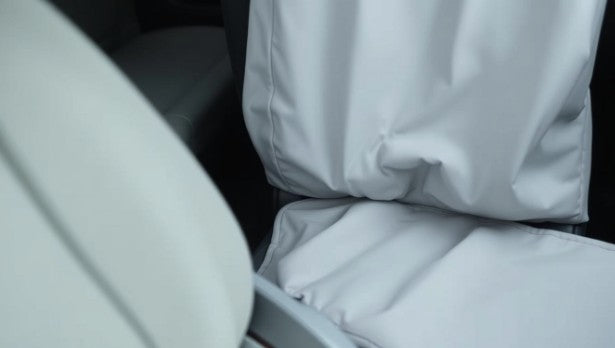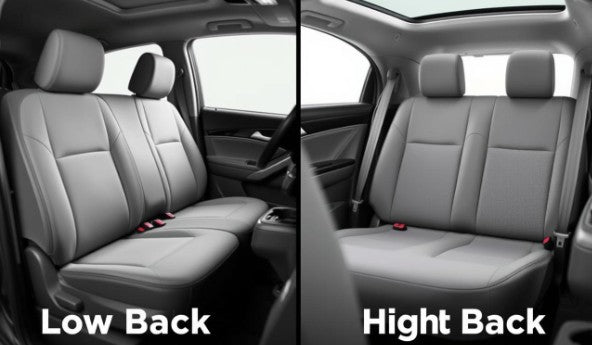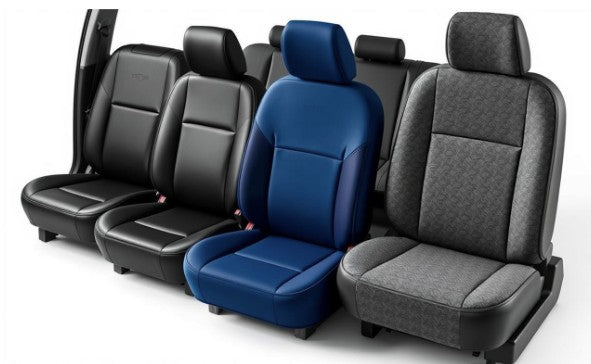Car seat covers promise to protect your vehicle's upholstery and enhance its appearance, but they're not without significant drawbacks. Before investing in seat covers for your vehicle, it's important to understand their potential disadvantages. From safety concerns to fit issues, this guide examines the key drawbacks of car seat covers to help you make an informed decision about whether they're right for your needs.
1. Safety Risks: Airbag Compatibility Issues
Perhaps the most serious disadvantage of car seat covers involves safety. Many modern vehicles feature side-impact airbags integrated directly into the seats. These airbags are designed to deploy through specially designed seams in your factory seats during a collision.
When you install seat covers that aren't specifically designed with airbag compatibility in mind, you risk creating a dangerous situation. Generic or poorly designed seat covers can prevent proper airbag deployment by:
- Blocking the airbag's deployment path
- Slowing deployment speed during critical moments
- Causing the airbag to deploy improperly, potentially causing injury
Even seat covers marketed as "universal fit" often fail to account for the specific airbag configuration in your vehicle model. This safety risk is particularly concerning since many car owners are unaware their seats contain airbags or don't realize their seat covers might interfere with this crucial safety feature.
Concerned About Airbag Safety?
If safety is your priority, learn how to identify truly airbag-compatible seat covers that won't compromise your vehicle's safety systems.
2. Poor Fit and Installation Challenges
Another significant disadvantage of car seat covers is the challenge of achieving a proper fit. While manufacturers often claim their covers are "universal" or "one-size-fits-most," the reality is that vehicle seats vary dramatically in size, shape, and design.
This fit issue manifests in several frustrating ways:
- Bunching and wrinkling that creates an unsightly appearance
- Covers that shift and move during normal use
- Difficulty accessing seat adjustment controls
- Challenges with seatbelt access and function
- Time-consuming and frustrating installation process
Even custom-designed seat covers can present installation challenges. Many require removing headrests or working with tight spaces between seats. What manufacturers describe as a "snug fit" often translates to an exhausting wrestling match with stubborn fabric and inadequate attachment mechanisms.
The result? Many car owners find themselves constantly readjusting slipping covers or eventually abandoning them altogether due to the ongoing hassle.
3. Comfort and Temperature Issues
Factory car seats are engineered with specific comfort considerations in mind. When you add seat covers, you potentially compromise this carefully designed comfort in several ways:
Comfort Disadvantages
- Reduced breathability leading to sweating and discomfort
- Heat retention in summer months, especially with vinyl or leather-look materials
- Cold, stiff surfaces in winter with certain materials
- Altered seat contours that affect ergonomics
- Reduced effectiveness of built-in lumbar support
Material choice significantly impacts comfort issues. Vinyl and leather-look covers, while easy to clean, create non-breathable barriers that trap heat and moisture. This can make long drives particularly uncomfortable during warm weather.
Neoprene covers, while water-resistant, similarly trap heat and can create a clammy feeling during extended use. Even fabric covers add an extra layer that reduces the breathability engineered into your original seats.
For vehicles with built-in heating or cooling functions in the seats, covers can significantly reduce their effectiveness by creating an insulating barrier between you and these comfort features.
4. Interference with Built-in Seat Features
Modern vehicle seats often include numerous built-in features designed to enhance comfort, convenience, and functionality. Seat covers can interfere with these features in frustrating ways:
- Heated and ventilated seats: Covers create a barrier that reduces heating efficiency and can completely block ventilation systems
- Memory position settings: Thick covers can alter the seat position enough to make saved memory positions inaccurate
- Seat adjustment controls: Covers may block access to electronic or manual adjustment controls
- Built-in massage functions: The effectiveness of massage features is significantly reduced through seat cover material
- Integrated seat belts: Some vehicles have seat belts built into the seat itself, which can be difficult to access with covers
While some premium seat covers attempt to address these issues with strategic cutouts or thinner material in key areas, these solutions are rarely perfect. The result is often a compromise between protection and functionality that leaves many car owners dissatisfied.
Have Premium Seats with Built-in Features?
Discover alternative protection options that won't interfere with your seat's advanced comfort and convenience features.
5. Material Degradation and Durability Concerns
While seat covers are meant to protect your original upholstery, the covers themselves are subject to wear and degradation that can create new problems:
Fabric Covers
- Fading from sun exposure
- Pilling and wear patterns in high-friction areas
- Staining that can be difficult to remove
- Stretching that leads to loose fit over time
Vinyl/Leatherette Covers
- Cracking and peeling, especially in hot climates
- Color transfer to clothing
- Hardening and loss of flexibility over time
- Tearing at seams and stress points
Budget-friendly seat covers often show signs of wear within months, particularly in vehicles that see daily use. Even premium covers eventually degrade, sometimes creating a worse appearance than the original seats would have developed naturally.
This degradation means you may find yourself replacing seat covers multiple times over the life of your vehicle, significantly increasing the total cost of this "protective" investment. In some cases, the degraded cover material can even damage or stain the original upholstery it was meant to protect.
6. Negative Aesthetic Impact
Vehicle manufacturers invest heavily in interior design, creating cohesive aesthetics that contribute significantly to the overall experience of the car. Seat covers, even high-quality ones, often detract from this carefully crafted interior design:
- Colors and patterns rarely match perfectly with other interior elements
- Texture differences between covers and original materials create visual discord
- Generic appearance that diminishes the premium feel of luxury vehicles
- Visible straps, elastic, or attachment mechanisms that create a cluttered look
- Misalignment with design lines and contours of the original seats
This aesthetic compromise is particularly noticeable in premium and luxury vehicles, where interior design is a key selling point. While some custom-designed covers attempt to mimic original upholstery, they rarely achieve the same refined appearance and integration with the overall interior design.
For many car enthusiasts and owners of premium vehicles, this aesthetic downgrade is simply too high a price to pay for the protective benefits seat covers provide.
7. Questionable Cost-Effectiveness
When evaluating the true value of seat covers, many car owners discover that the cost-benefit equation doesn't always work in their favor:
|
Cost Factor |
Budget Covers |
Premium Covers |
Alternative (Professional Cleaning) |
|
Initial Investment |
$30-$80 |
$200-$600 |
$100-$200 per cleaning |
|
Lifespan |
6-12 months |
2-5 years |
N/A (preserves original upholstery) |
|
Replacement Needs |
Multiple replacements needed |
1-2 replacements over vehicle life |
Recommended annually |
|
Impact on Resale Value |
Potentially negative |
Neutral to slightly positive |
Positive |
Budget-friendly universal covers often wear out quickly, requiring frequent replacement that adds up over time. Meanwhile, premium custom-fit covers represent a significant upfront investment that may not pay off if you don't keep the vehicle long-term.
Additionally, many car owners discover that regular professional cleaning of their original upholstery, combined with spot treatments as needed, can maintain their seats in excellent condition for less than the cost of quality seat covers.
For leased vehicles, seat covers may not make financial sense at all, as the limited use period doesn't justify the investment—especially when considering that properly maintained original upholstery is perfectly acceptable at lease-end.
Alternatives to Traditional Car Seat Covers
If the disadvantages of car seat covers have you reconsidering your options, several alternatives can provide protection without the drawbacks:
Fabric Protection Treatments
Professional-grade fabric protectants create an invisible barrier against stains and spills without changing the look, feel, or function of your seats.
- Preserves original appearance and comfort
- No interference with safety features
- Typically needs reapplication every 6-12 months
Temporary Seat Protectors
For specific situations like transporting pets or after a beach trip, removable seat protectors offer temporary protection without permanent installation.
- Easy to install and remove as needed
- No long-term comfort or safety issues
- Ideal for occasional protection needs
Regular Professional Cleaning
Scheduled professional cleaning can maintain your original upholstery in excellent condition without the need for covers.
- Preserves factory appearance and function
- Removes embedded dirt and stains
- Often more cost-effective long-term
These alternatives allow you to protect your vehicle's interior while avoiding the safety concerns, comfort issues, and aesthetic compromises associated with traditional seat covers.
When Do Car Seat Covers Make Sense Despite the Disadvantages?
Despite their drawbacks, seat covers remain a practical solution in certain scenarios:
- Work vehicles that are regularly exposed to dirt, tools, and harsh conditions
- Vehicles used for outdoor activities like hunting, fishing, or camping
- Cars with already damaged upholstery that needs to be concealed
- Vehicles used for rideshare services that see high passenger turnover
- Family vehicles with young children prone to spills and accidents
In these situations, the protective benefits may outweigh the disadvantages—particularly if you choose high-quality covers specifically designed for your vehicle model with proper safety certifications.
If you do decide seat covers are necessary for your situation, invest in the highest quality, custom-fit options you can afford, with particular attention to airbag compatibility and proper installation.
Making an Informed Decision About Car Seat Covers
Car seat covers present a classic case of weighing potential benefits against significant drawbacks. While they offer protection for your vehicle's upholstery, they come with considerable compromises in safety, comfort, functionality, and aesthetics.
Before purchasing seat covers, honestly assess your specific needs and priorities. Consider whether alternatives like fabric protection treatments or regular professional cleaning might better serve your goals without the disadvantages inherent to seat covers.
If you do decide that seat covers are right for your situation, invest in high-quality, vehicle-specific options that are certified for airbag compatibility. Proper research and installation will help minimize the drawbacks while maximizing the protective benefits you're seeking.
Still Considering Seat Covers?
If you've weighed the disadvantages and still want to explore your options, find seat covers specifically designed to address these common concerns.
Frequently Asked Questions About Car Seat Covers
Do all car seat covers interfere with side airbags?
Not all seat covers interfere with side airbags, but many do—especially universal-fit and budget options. Look specifically for covers that are certified as "airbag compatible" or "airbag tested" for your exact vehicle make and model. These specially designed covers typically feature breakaway seams that allow airbags to deploy properly in an accident.
Will seat covers void my vehicle's warranty?
Seat covers themselves typically won't void your entire vehicle warranty. However, if a seat cover causes damage to your vehicle's electrical systems, airbags, or other components, repairs related to that damage might not be covered. Additionally, if a seat cover prevents proper airbag deployment in an accident, it could potentially complicate insurance claims.
Are there any seat covers that don't affect heated seats?
While all seat covers create some barrier that reduces heating efficiency, thinner materials like certain fabrics and mesh have less impact than thicker options like neoprene or sheepskin. Some premium seat covers are specifically designed with heating elements in mind, using materials that conduct heat more effectively. However, even these will reduce heating efficiency to some degree.




Leave a comment
This site is protected by hCaptcha and the hCaptcha Privacy Policy and Terms of Service apply.